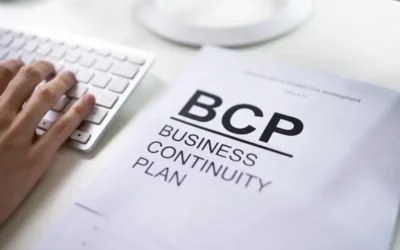Disaster can strike at any moment, and large or small, no business is immune to such an existential risk. Whether in the form of a cyber attack, natural disaster or human error, these unplanned incidents can be detrimental to a business, and with so many businesses increasingly dependent on their IT infrastructure to operate and make sales, a Disaster Recovery Plan (DRP) should not be a mere afterthought, but an integral part of your business continuity plan.
In this article, we are going to discuss how to create a Disaster Recovery Plan for your business.
What is a disaster recovery plan?
A Disaster Recovery Plan (DRP) is a guide that outlines the steps and procedures a business must take when a disaster occurs to get operations back up and running.
From strategies to minimise the effects of the incident to the roles and responsibilities that each person must cover, a DRP documents the actions that need to be taken before, during and after so there is minimal disruption and no time is wasted.
Why do you need a disaster recovery plan?
Statistics show that 93% of businesses that suffer a major data disaster and don’t have a recovery plan in place will go out of business within one year. Is there a bigger ‘why?’ needed than that?
Even those that manage to survive an incident without a plan can experience a loss of revenue or customers, reputational and brand damage, and even the risk of litigation.
These effects can take years to fully recover from, greatly impacting the growth of the business.
Drafting a disaster recovery plan
So exactly how do you create a disaster recovery plan for your business?
A strong Disaster Recovery Plan should include some crucial key elements so every person who reads it will understand its purpose and overall objectives.
We have outlined some of these below:
Know your goal
What is the ultimate goal of your disaster recovery plan? As in, what is the intention for creating it in the first place?
To minimise interruptions to operations, to limit the extent of disruption and damage, to minimise the economic impact of the interruption, to establish alternative means of operation in advance, to train personnel with emergency procedures? These are all examples of goals that should be included in your Disaster Recovery Plan.
This section should also outline maximum acceptable downtime and recovery time targets so everyone understands the urgency involved.
Know your threats
Although you may not be able to predict every single possible scenario that could occur, through research you should be able to identify a standard list of potential threats.
Knowing the dangers and understanding the risks involved can help you to better prepare for the sequence of events that could follow.
Know your assets
It is crucial to assess your IT infrastructure and understand what measures you can take to limit the damage caused by a disaster and restore systems as quickly as possible.
Catalogue your critical assets – those that the business cannot operate without. List the important assets – applications that are used at least once per day and can disrupt normal operations. Group the less important assets – applications that are less frequently used.
The purpose of this review is to ensure that you are working in order of priority and fixing the areas that could have the greatest negative impact first.
Know your limits
Every business is different and will have varying limits to what they can withstand. 24 hours of downtime may not have a huge impact on one business, but have catastrophic consequences for another.
Understand how much downtime is tolerable and put steps in place to monitor this.
Know your team
As mentioned already, it is crucial that every team member understands the role they and their colleagues play in recovery.
Your Disaster Recovery Plan should outline exactly who is doing what during an incident so no skills go to waste and everyone is where they should be.
Know it works
It is a good idea to factor testing into the Disaster Recovery Plan. Frequent testing ensures the plan works.
There may be tweaks or a refresh needed from time to time due to staff changes, IT infrastructure additions, etc but by staying on top of this and conducting a regular review of your DRP, you will always be ahead of the game.
Know it’s safe
Back up, back up, back up!
It is vital to have a reliable data backup system in place when faced with potential data loss.
When a reported 60% of small businesses that experience a data loss shut down within six months, it is essential to include data and backups as part of the DRP.
Implement an effective DR Plan with our backup and disaster recovery services
Securing the success of your business means being proactive rather than reactive. It’s far better to build the prevention rather than scramble to source the cure.
A Disaster Recovery Plan will ensure you have taken every precaution possible and that you have the right people in place when disaster strikes. A solid DRP will help to minimise disruption, limit damages and allow your business to recover as quickly as possible.
At Calnet IT Solutions, our Backup and Disaster Recovery services can be put in place to do just that.
As a certified Microsoft Gold Partner, our reputation is built on our commitment to our customers and understanding their requirements.
Get in touch with us today to get started.






